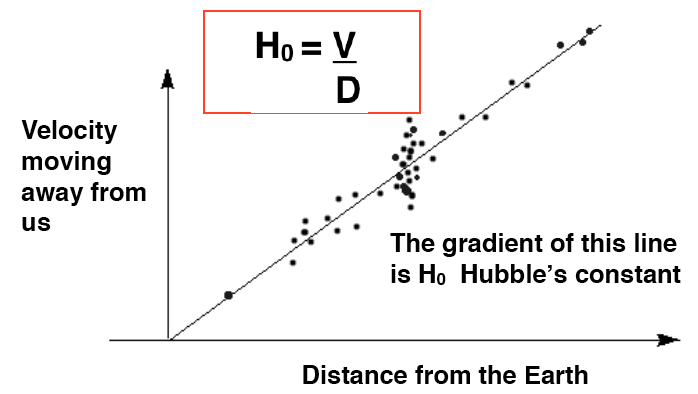Using Hubble’s Law to calculate the age of the universe
We have several methods of calculating the distance of other galaxies from the earth (see Cepeid variables and type 1a supernova). From Hubble’s observations we know that the ratio of velocity to distance is constant and in this calculation we assume that the universe has been expanding since the big bang with all the constituents moving at constant velocities relative to one another. (That is the big assumption we are making we are assuming the velocity is constant and so the rate of expansion has been constant)
From the ratio of velocity to distance from Earth we measure Hubble's Constant.
Using the value calculated we get from now a large expanding universe with galaxies moving apart at high speed.
Starting from now a large expanding universe with galaxies moving apart at high speed. If we imagine that we go backwards in time, all the matter in the universe was much closer together. If we go further back then at the point of the big bang all matter was at a single point. We want to calculate that time
The gradient of the line of the graph above is V/T which is Hubble's constant
From Ho= V/T we get 1/Ho = D/V and distance divided by velocity is time, so T = 1/Ho
where the 1 represents one parsec and taking Hubble’s constant to be 71 kilometres per second per megaparsec, so:
1000 metres in a kilometre and 3.09 x 1022 metres in a megaparsec
The age of the universe from now back to the big bang is 3.09 x 1022 / 71000 seconds
That works out to 13.8 billion years.
Other pages of notes and video on astronomy which may be useful are:
Units of distance notes and video Measuring distance by parallax/triangulation notes and video Life cycle of stars Geostationary and polar satellites notes and video Big Bang theory and evidence Development of the Universe after the Big Bang Real and apparent magnitude Hubble's Law and measuring distance notes and video Using Hertzsprung Russell diagrams notes and video Cepheid variable stars Type 1A supernova

